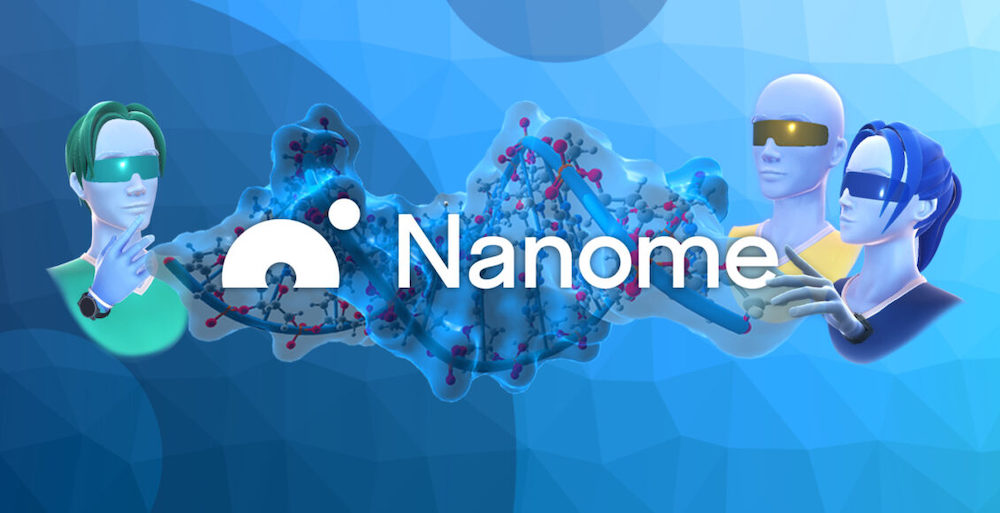Oculus Co-Founder Invests in VR Startup Nanome
The Virtual Reality platform Nanome helps scientists to better understand molecules, a use-case that could help in the future development of drugs.
3D visualization is one of the oldest and most-established use-cases for virtual reality. A user wearing a virtual reality headset can visualize and study product designs in 3D before they go into production. 3D visualization can also be used to display data sets in three dimensions to enable researchers, analysts and data scientists better recognize complex relationships between data sets.

There are already a number of VR collaboration and 3D visualization tools including Spatial, Glue, Hubs and Vive XR Suite. However, none of these are focused specifically on specialized scientific research. Nanome therefore offers something new and niche as far as VR collaboration and visualization tools go. The startup just announced a successful funding round that netted $3 million.
The funding round was led by Bullpen Capital with participation from Oculus co-founder Michael Antonov’s Formic Adventures along with other angel investors. Nanome’s VR platform has been there since 2018 and is available on both Steam and Oculus Store. The new funds will be channeled into expanding the VR startup’s team and building new partnerships.
According to Nanome CEO Steve McCloskey, the startup has had a “compelling vision about what scientific collaboration should look like” and its VR platform aims to equip scientists working in various fields such as discovering new ways to combat diseases, addressing climate change and improving people’s lives. McCloskey states that Nanome provides an intuitive virtual interface where scientists can experiment, design and learn “at the nanoscale.” He noted that the new funding will give Nanome the “firepower” to increase its impact, support more research initiatives and continue its work in revolutionizing biotech and scientific research.
Nanome began as a visualization tool for facilitating R&D by structural biologists and medicinal and computational chemists. It has since grown into an open platform for virtual collaboration. The startup stated that during the COVID-19 pandemic, many scientists and organizations used Nanome’s platform for assessing candidate molecules’ ability to bind viral proteins in 3D.
The Nanome platform leverages the power of the virtual reality medium to display molecules, their chemical compositions and interactions, in virtual reality.
Traditionally, scientists working with molecules use screenshots or screen-sharing along with the mouse cursor and zoom to communicate their findings and solicit feedback from other team members.
The Nanome platform has been designed to simplify this communication by bringing the participating scientists together into the same virtual space where they can collaborate on complex molecules. Such a use-case could have lots of cost benefits in the future such as reducing the cost of drug development.
Nanome Looking to Expand
The startup’s CEO McCloskey came up with the idea of Nanome while he was studying nano-engineering at the UC San Diego. The visualization tool has since grown into a collaboration platform for chemists and biologists.
The capital raised in the latest funding round will go into new partnerships as well as in the expansion of its development and science team. Nanome has so far worked with companies in the food and beverage industry as well as on projects to develop more sustainable batteries. In its next phase, Nanome wants to focus on the pharmaceutical industry, synthetic biology as well as on educational institutes.
Nanome is free for personal use on HTC Vive, Oculus Rift and Valve Index headset. There are licensing structures for academic and commercial uses. Check out the video below of Nanome employees demonstrating in VR how mRNA vaccines work.
https://virtualrealitytimes.com/2021/02/13/oculus-co-founder-invests-in-vr-startup-nanome/https://virtualrealitytimes.com/wp-content/uploads/2021/02/Nanome-600x308.jpghttps://virtualrealitytimes.com/wp-content/uploads/2021/02/Nanome-150x90.jpgBusinessStartupsThe Virtual Reality platform Nanome helps scientists to better understand molecules, a use-case that could help in the future development of drugs. 3D visualization is one of the oldest and most-established use-cases for virtual reality. A user wearing a virtual reality headset can visualize and study product designs in 3D...Sam OchanjiSam Ochanji[email protected]EditorVirtual Reality Times - Metaverse & VR
